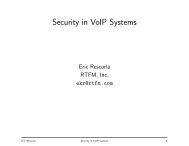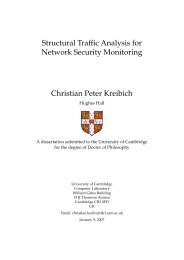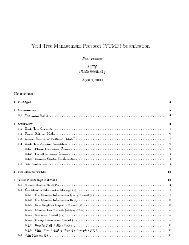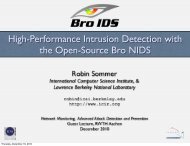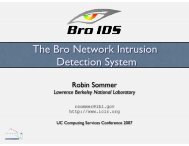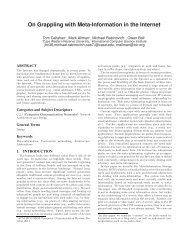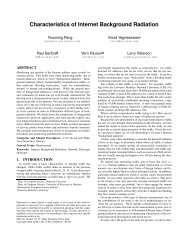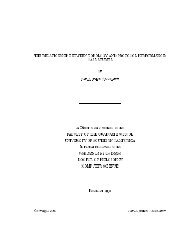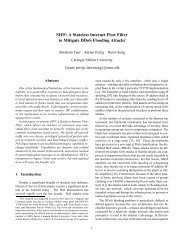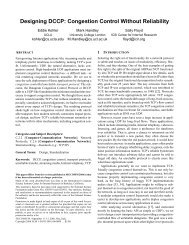Enhancing Byte-Level Network Intrusion Detection Signatures with ...
Enhancing Byte-Level Network Intrusion Detection Signatures with ...
Enhancing Byte-Level Network Intrusion Detection Signatures with ...
You also want an ePaper? Increase the reach of your titles
YUMPU automatically turns print PDFs into web optimized ePapers that Google loves.
In this paper, we develop the concept of contextual signatures,<br />
in which the traditional form of string-based signature matching is<br />
augmented by incorporating additional context on different levels<br />
when evaluating the signatures. First of all, we design and implement<br />
an efficient pattern matcher similar in spirit to traditional signature<br />
engines used in other NIDS. But already on this low-level<br />
we enable the use of additional context by (i) providing full regular<br />
expressions instead of fixed strings, and (ii) giving the signature<br />
engine a notion of full connection state, which allows it to correlate<br />
multiple interdependent matches in both directions of a user<br />
session. Then, if the signature engine reports the match of a signature,<br />
we use this event as the start of a decision process, instead<br />
of an alert by itself as is done by most signature-matching NIDSs.<br />
Again, we use additional context to judge whether something alertworthy<br />
has indeed occurred. This time the context is located on a<br />
higher-level, containing our knowledge about the network that we<br />
have either explicitly defined or already learned during operation.<br />
In §3.5, we will show several examples to demonstrate how the<br />
concept of contextual signatures can help to eliminate most of the<br />
limitations of traditional signatures discussed above. We will see<br />
that regular expressions, interdependent signatures, and knowledge<br />
about the particular environment have significant potential to reduce<br />
the false positive rate and to identify failed attack attempts. For<br />
example, we can consider the server’s response to an attack and<br />
the set of software it is actually running—its vulnerability profile—<br />
to decide whether an attack has succeeded. In addition, treating<br />
signature matches as events rather than alerts enables us to analyze<br />
them on a meta-level as well, which we demonstrate by identifying<br />
exploit scans (scanning multiple hosts for a known vulnerability).<br />
Instrumenting signatures to consider additional context has to be<br />
performed manually. For each signature, we need to determine what<br />
context might actually help to increase its performance. While this<br />
is tedious for large sets of already-existing signatures, it is not an<br />
extra problem when developing new ones, as such signatures have<br />
to be similarly adjusted to the specifics of particular attacks anyway.<br />
Contextual signatures serve as a building block for increasing the<br />
expressivess of signatures; not as a stand-alone solution.<br />
We implemented the concept of contextual signatures in the<br />
framework already provided by the freeware NIDS Bro [25]. In<br />
contrast to most NIDSs, Bro is fundamentally neither an anomalybased<br />
system nor a signature-based system. It is instead partitioned<br />
into a protocol analysis component and a policy script component.<br />
The former feeds the latter via generating a stream of events that<br />
reflect different types of activity detected by the protocol analysis;<br />
consequently, the analyzer is also referred to as the event engine.<br />
For example, when the analyzer sees the establishment of<br />
a TCP connection, it generates a connection established<br />
event; when it sees an HTTP request it generates http request<br />
and for the corresponding reply http reply; and when the event<br />
engine’s heuristics determine that a user has successfully authenticated<br />
during a Telnet or Rlogin session, it generates login success<br />
(likewise, each failed attempt results in a login failure<br />
event).<br />
Bro’s event engine is policy-neutral: it does not consider any<br />
particular events as reflecting trouble. It simply makes the events<br />
available to the policy script interpreter. The interpreter then executes<br />
scripts written in Bro’s custom scripting language in order<br />
to define the response to the stream of events. Because the language<br />
includes rich data types, persistent state, and access to timers<br />
and external programs, the response can incorporate a great deal of<br />
context in addition to the event itself. The script’s reaction to a particular<br />
event can range from updating arbitrary state (for example,<br />
tracking types of activity by address or address pair, or grouping re-<br />
lated connections into higher-level “sessions”) to generating alerts<br />
(e.g., via syslog) or invoking programs for a reactive response.<br />
More generally, a Bro policy script can implement signature-style<br />
matching—for example, inspecting the URIs in Web requests, the<br />
MIME-encoded contents of email (which the event engine will first<br />
unpack), the user names and keystrokes in login sessions, or the<br />
filenames in FTP sessions—but at a higher semantic level than as<br />
just individual packets or generic TCP byte streams.<br />
Bro’s layered approach is very powerful as it allows a wide range<br />
of different applications. But it has a significant shortcoming:<br />
while, as discussed above, the policy script is capable of performing<br />
traditional signature-matching, doing so can be cumbersome for<br />
large sets of signatures, because each signature has to be coded as<br />
part of a script function. This is in contrast to the concise, low-level<br />
languages used by most traditional signature-based systems. In addition,<br />
if the signatures are matched sequentially, then the overhead<br />
of the matching can become prohibitive. Finally, a great deal of<br />
community effort is already expended on developing and disseminating<br />
packet-based and byte-stream-based signatures. For example,<br />
the 1.9.0 release of Snort comes <strong>with</strong> a library of 1,715 signatures<br />
[2]. It would be a major advantage if we could leverage these<br />
efforts by incorporating such libraries.<br />
Therefore, one motivation for this work is to combine Bro’s flexibility<br />
<strong>with</strong> the capabilities of other NIDSs by implementing a signature<br />
engine. But in contrast to traditional systems, which use their<br />
signature matcher more or less on its own, we tightly integrate it<br />
into Bro’s architecture in order to provide contextual signatures. As<br />
discussed above, there are two main levels on which we use additional<br />
context for signature matching. First, at a detailed level, we<br />
extend the expressiveness of signatures. Although byte-level pattern<br />
matching is a central part of NIDSs, most only allow signatures to<br />
be expressed in terms of fixed strings. Bro, on the other hand, already<br />
provides regular expressions for use in policy scripts, and we<br />
use them for signatures as well. The expressiveness of such patterns<br />
provides us <strong>with</strong> an immediate way to express syntactic context.<br />
For example, <strong>with</strong> regular expressions it is easy to express the notion<br />
“string XYZ but only if preceded at some point earlier by string<br />
ABC”. An important point to keep in mind regarding regular expression<br />
matching is that, once we have fully constructed the matcher,<br />
which is expressed as a Deterministic Finite Automaton (DFA), the<br />
matching can be done in O(n) time for n characters in the input,<br />
and also Ω(n) time. (That is, the matching always takes time linear<br />
in the size of the input, regardless of the specifics of the input.) The<br />
“parallel Boyer-Moore” approaches that have been explored in the<br />
literature for fast matching of multiple fixed strings for Snort [12, 8]<br />
have a wide range of running times—potentially sublinear in n, but<br />
also potentially superlinear in n. So, depending on the particulars<br />
of the strings we want to match and the input against which we do<br />
the matching, regular expressions might prove fundamentally more<br />
efficient, or might not; we need empirical evaluations to determine<br />
the relative performance in practice. In addition, the construction of<br />
a regular expression matcher requires time potentially exponential<br />
in the length of the expression, clearly prohibitive, a point to which<br />
we return in §3.1.<br />
Second, on a higher level, we use Bro’s rich contextual state to<br />
implement our improvements to plain matching described above.<br />
Making use of Bro’s architecture, our engine sends events to the<br />
policy layer. There, the policy script can use all of Bro’s already<br />
existing mechanisms to decide how to react. We show several such<br />
examples in §3.5.<br />
Due to Snort’s large user base, it enjoys a comprehensive and<br />
up-to-date set of signatures. Therefore, although for flexibility we<br />
have designed a custom signature language for Bro, we make use




